Managing Innovation in Business for HSBC Bank
VerifiedAdded on 2023/06/10
|12
|3757
|133
AI Summary
This report discusses managing innovation in business for HSBC Bank. It covers future industry trends, innovation requirements, and building future innovation capabilities for the organization. The report also explores the importance of organizational culture in implementing effective innovative practices. The use of Biometric technology, microservices, chatbots, and blockchain technology are some of the future innovations that HSBC Bank can adopt for better productivity and growth.
Contribute Materials
Your contribution can guide someone’s learning journey. Share your
documents today.
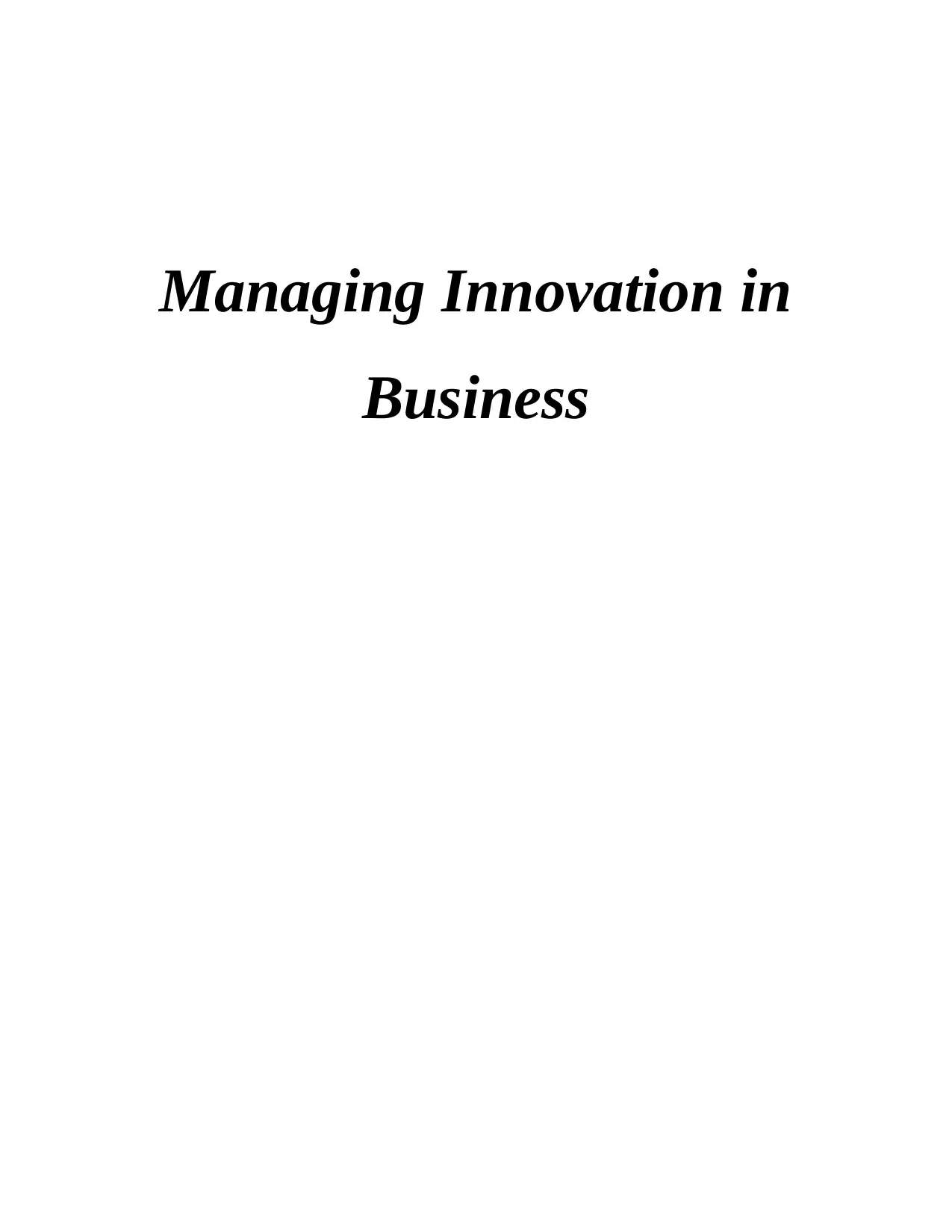
Managing Innovation in
Business
Business
Secure Best Marks with AI Grader
Need help grading? Try our AI Grader for instant feedback on your assignments.
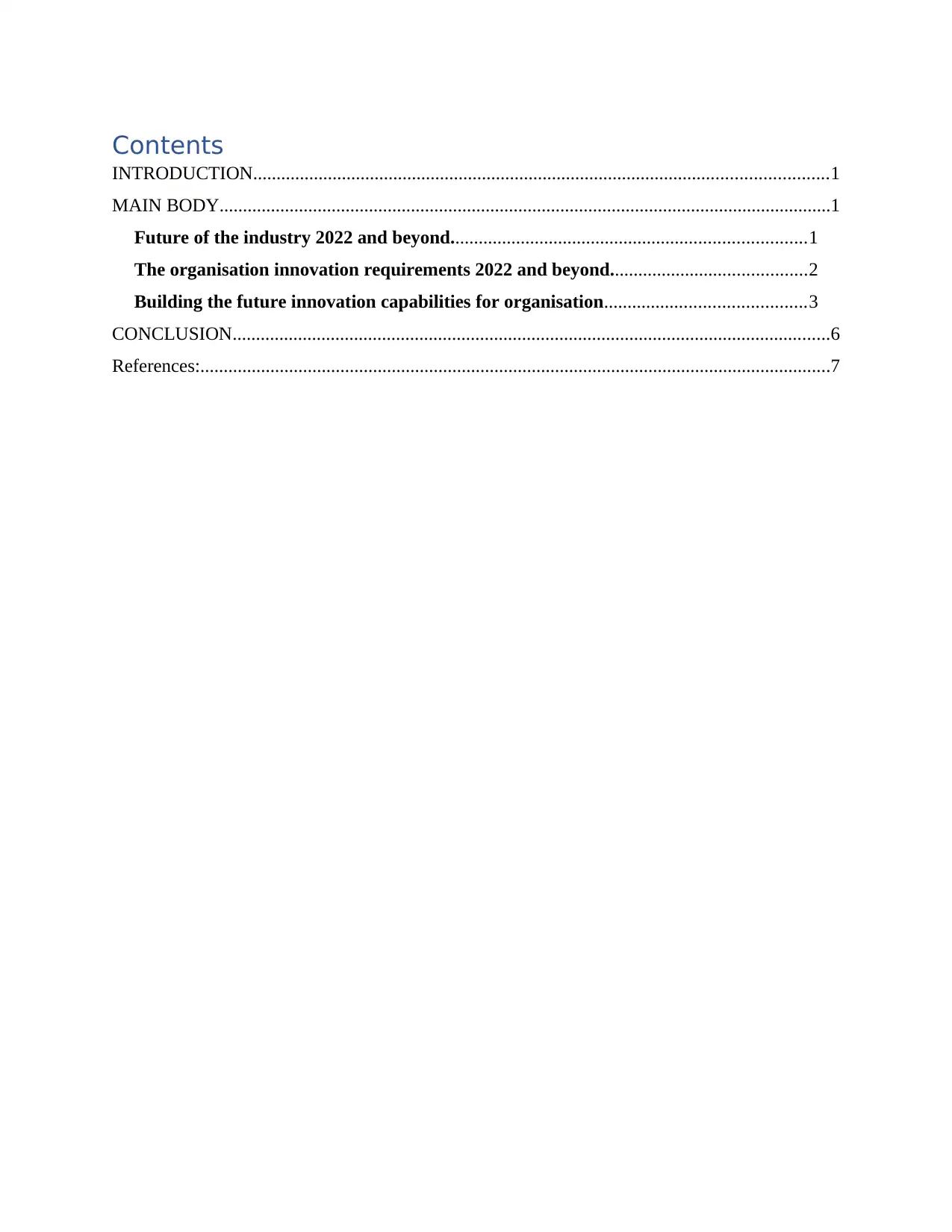
Contents
INTRODUCTION...........................................................................................................................1
MAIN BODY...................................................................................................................................1
Future of the industry 2022 and beyond............................................................................1
The organisation innovation requirements 2022 and beyond..........................................2
Building the future innovation capabilities for organisation...........................................3
CONCLUSION................................................................................................................................6
References:.......................................................................................................................................7
INTRODUCTION...........................................................................................................................1
MAIN BODY...................................................................................................................................1
Future of the industry 2022 and beyond............................................................................1
The organisation innovation requirements 2022 and beyond..........................................2
Building the future innovation capabilities for organisation...........................................3
CONCLUSION................................................................................................................................6
References:.......................................................................................................................................7
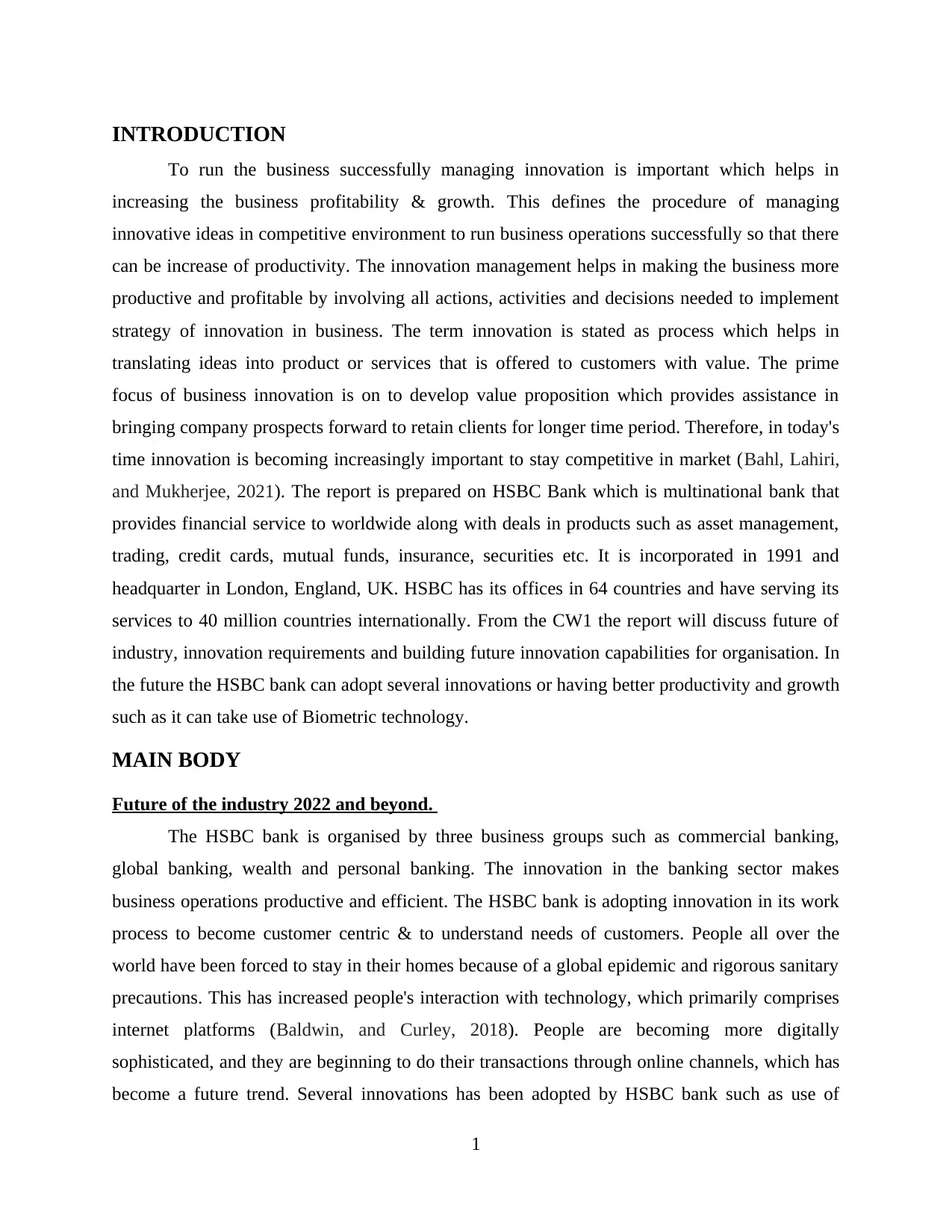
INTRODUCTION
To run the business successfully managing innovation is important which helps in
increasing the business profitability & growth. This defines the procedure of managing
innovative ideas in competitive environment to run business operations successfully so that there
can be increase of productivity. The innovation management helps in making the business more
productive and profitable by involving all actions, activities and decisions needed to implement
strategy of innovation in business. The term innovation is stated as process which helps in
translating ideas into product or services that is offered to customers with value. The prime
focus of business innovation is on to develop value proposition which provides assistance in
bringing company prospects forward to retain clients for longer time period. Therefore, in today's
time innovation is becoming increasingly important to stay competitive in market (Bahl, Lahiri,
and Mukherjee, 2021). The report is prepared on HSBC Bank which is multinational bank that
provides financial service to worldwide along with deals in products such as asset management,
trading, credit cards, mutual funds, insurance, securities etc. It is incorporated in 1991 and
headquarter in London, England, UK. HSBC has its offices in 64 countries and have serving its
services to 40 million countries internationally. From the CW1 the report will discuss future of
industry, innovation requirements and building future innovation capabilities for organisation. In
the future the HSBC bank can adopt several innovations or having better productivity and growth
such as it can take use of Biometric technology.
MAIN BODY
Future of the industry 2022 and beyond.
The HSBC bank is organised by three business groups such as commercial banking,
global banking, wealth and personal banking. The innovation in the banking sector makes
business operations productive and efficient. The HSBC bank is adopting innovation in its work
process to become customer centric & to understand needs of customers. People all over the
world have been forced to stay in their homes because of a global epidemic and rigorous sanitary
precautions. This has increased people's interaction with technology, which primarily comprises
internet platforms (Baldwin, and Curley, 2018). People are becoming more digitally
sophisticated, and they are beginning to do their transactions through online channels, which has
become a future trend. Several innovations has been adopted by HSBC bank such as use of
1
To run the business successfully managing innovation is important which helps in
increasing the business profitability & growth. This defines the procedure of managing
innovative ideas in competitive environment to run business operations successfully so that there
can be increase of productivity. The innovation management helps in making the business more
productive and profitable by involving all actions, activities and decisions needed to implement
strategy of innovation in business. The term innovation is stated as process which helps in
translating ideas into product or services that is offered to customers with value. The prime
focus of business innovation is on to develop value proposition which provides assistance in
bringing company prospects forward to retain clients for longer time period. Therefore, in today's
time innovation is becoming increasingly important to stay competitive in market (Bahl, Lahiri,
and Mukherjee, 2021). The report is prepared on HSBC Bank which is multinational bank that
provides financial service to worldwide along with deals in products such as asset management,
trading, credit cards, mutual funds, insurance, securities etc. It is incorporated in 1991 and
headquarter in London, England, UK. HSBC has its offices in 64 countries and have serving its
services to 40 million countries internationally. From the CW1 the report will discuss future of
industry, innovation requirements and building future innovation capabilities for organisation. In
the future the HSBC bank can adopt several innovations or having better productivity and growth
such as it can take use of Biometric technology.
MAIN BODY
Future of the industry 2022 and beyond.
The HSBC bank is organised by three business groups such as commercial banking,
global banking, wealth and personal banking. The innovation in the banking sector makes
business operations productive and efficient. The HSBC bank is adopting innovation in its work
process to become customer centric & to understand needs of customers. People all over the
world have been forced to stay in their homes because of a global epidemic and rigorous sanitary
precautions. This has increased people's interaction with technology, which primarily comprises
internet platforms (Baldwin, and Curley, 2018). People are becoming more digitally
sophisticated, and they are beginning to do their transactions through online channels, which has
become a future trend. Several innovations has been adopted by HSBC bank such as use of
1
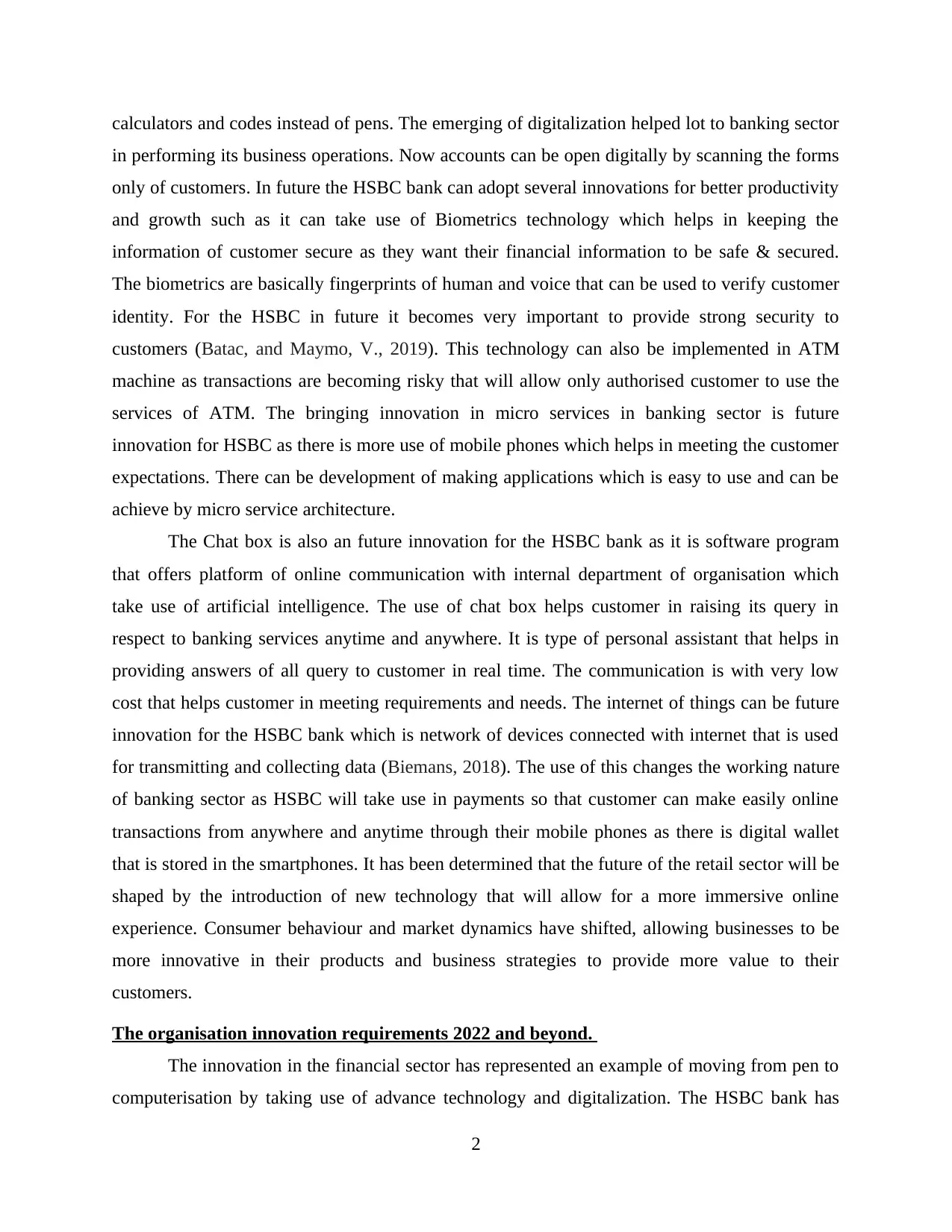
calculators and codes instead of pens. The emerging of digitalization helped lot to banking sector
in performing its business operations. Now accounts can be open digitally by scanning the forms
only of customers. In future the HSBC bank can adopt several innovations for better productivity
and growth such as it can take use of Biometrics technology which helps in keeping the
information of customer secure as they want their financial information to be safe & secured.
The biometrics are basically fingerprints of human and voice that can be used to verify customer
identity. For the HSBC in future it becomes very important to provide strong security to
customers (Batac, and Maymo, V., 2019). This technology can also be implemented in ATM
machine as transactions are becoming risky that will allow only authorised customer to use the
services of ATM. The bringing innovation in micro services in banking sector is future
innovation for HSBC as there is more use of mobile phones which helps in meeting the customer
expectations. There can be development of making applications which is easy to use and can be
achieve by micro service architecture.
The Chat box is also an future innovation for the HSBC bank as it is software program
that offers platform of online communication with internal department of organisation which
take use of artificial intelligence. The use of chat box helps customer in raising its query in
respect to banking services anytime and anywhere. It is type of personal assistant that helps in
providing answers of all query to customer in real time. The communication is with very low
cost that helps customer in meeting requirements and needs. The internet of things can be future
innovation for the HSBC bank which is network of devices connected with internet that is used
for transmitting and collecting data (Biemans, 2018). The use of this changes the working nature
of banking sector as HSBC will take use in payments so that customer can make easily online
transactions from anywhere and anytime through their mobile phones as there is digital wallet
that is stored in the smartphones. It has been determined that the future of the retail sector will be
shaped by the introduction of new technology that will allow for a more immersive online
experience. Consumer behaviour and market dynamics have shifted, allowing businesses to be
more innovative in their products and business strategies to provide more value to their
customers.
The organisation innovation requirements 2022 and beyond.
The innovation in the financial sector has represented an example of moving from pen to
computerisation by taking use of advance technology and digitalization. The HSBC bank has
2
in performing its business operations. Now accounts can be open digitally by scanning the forms
only of customers. In future the HSBC bank can adopt several innovations for better productivity
and growth such as it can take use of Biometrics technology which helps in keeping the
information of customer secure as they want their financial information to be safe & secured.
The biometrics are basically fingerprints of human and voice that can be used to verify customer
identity. For the HSBC in future it becomes very important to provide strong security to
customers (Batac, and Maymo, V., 2019). This technology can also be implemented in ATM
machine as transactions are becoming risky that will allow only authorised customer to use the
services of ATM. The bringing innovation in micro services in banking sector is future
innovation for HSBC as there is more use of mobile phones which helps in meeting the customer
expectations. There can be development of making applications which is easy to use and can be
achieve by micro service architecture.
The Chat box is also an future innovation for the HSBC bank as it is software program
that offers platform of online communication with internal department of organisation which
take use of artificial intelligence. The use of chat box helps customer in raising its query in
respect to banking services anytime and anywhere. It is type of personal assistant that helps in
providing answers of all query to customer in real time. The communication is with very low
cost that helps customer in meeting requirements and needs. The internet of things can be future
innovation for the HSBC bank which is network of devices connected with internet that is used
for transmitting and collecting data (Biemans, 2018). The use of this changes the working nature
of banking sector as HSBC will take use in payments so that customer can make easily online
transactions from anywhere and anytime through their mobile phones as there is digital wallet
that is stored in the smartphones. It has been determined that the future of the retail sector will be
shaped by the introduction of new technology that will allow for a more immersive online
experience. Consumer behaviour and market dynamics have shifted, allowing businesses to be
more innovative in their products and business strategies to provide more value to their
customers.
The organisation innovation requirements 2022 and beyond.
The innovation in the financial sector has represented an example of moving from pen to
computerisation by taking use of advance technology and digitalization. The HSBC bank has
2
Secure Best Marks with AI Grader
Need help grading? Try our AI Grader for instant feedback on your assignments.
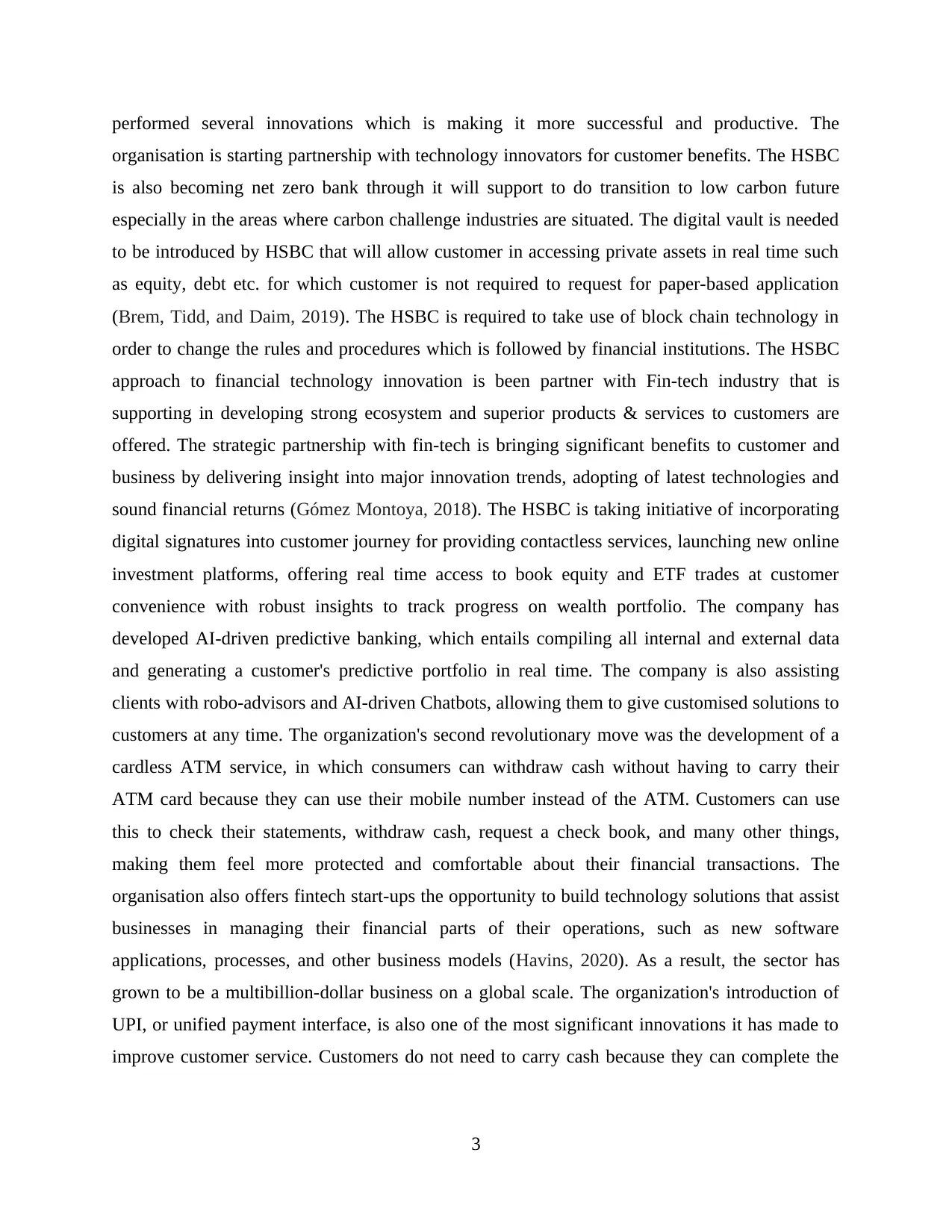
performed several innovations which is making it more successful and productive. The
organisation is starting partnership with technology innovators for customer benefits. The HSBC
is also becoming net zero bank through it will support to do transition to low carbon future
especially in the areas where carbon challenge industries are situated. The digital vault is needed
to be introduced by HSBC that will allow customer in accessing private assets in real time such
as equity, debt etc. for which customer is not required to request for paper-based application
(Brem, Tidd, and Daim, 2019). The HSBC is required to take use of block chain technology in
order to change the rules and procedures which is followed by financial institutions. The HSBC
approach to financial technology innovation is been partner with Fin-tech industry that is
supporting in developing strong ecosystem and superior products & services to customers are
offered. The strategic partnership with fin-tech is bringing significant benefits to customer and
business by delivering insight into major innovation trends, adopting of latest technologies and
sound financial returns (Gómez Montoya, 2018). The HSBC is taking initiative of incorporating
digital signatures into customer journey for providing contactless services, launching new online
investment platforms, offering real time access to book equity and ETF trades at customer
convenience with robust insights to track progress on wealth portfolio. The company has
developed AI-driven predictive banking, which entails compiling all internal and external data
and generating a customer's predictive portfolio in real time. The company is also assisting
clients with robo-advisors and AI-driven Chatbots, allowing them to give customised solutions to
customers at any time. The organization's second revolutionary move was the development of a
cardless ATM service, in which consumers can withdraw cash without having to carry their
ATM card because they can use their mobile number instead of the ATM. Customers can use
this to check their statements, withdraw cash, request a check book, and many other things,
making them feel more protected and comfortable about their financial transactions. The
organisation also offers fintech start-ups the opportunity to build technology solutions that assist
businesses in managing their financial parts of their operations, such as new software
applications, processes, and other business models (Havins, 2020). As a result, the sector has
grown to be a multibillion-dollar business on a global scale. The organization's introduction of
UPI, or unified payment interface, is also one of the most significant innovations it has made to
improve customer service. Customers do not need to carry cash because they can complete the
3
organisation is starting partnership with technology innovators for customer benefits. The HSBC
is also becoming net zero bank through it will support to do transition to low carbon future
especially in the areas where carbon challenge industries are situated. The digital vault is needed
to be introduced by HSBC that will allow customer in accessing private assets in real time such
as equity, debt etc. for which customer is not required to request for paper-based application
(Brem, Tidd, and Daim, 2019). The HSBC is required to take use of block chain technology in
order to change the rules and procedures which is followed by financial institutions. The HSBC
approach to financial technology innovation is been partner with Fin-tech industry that is
supporting in developing strong ecosystem and superior products & services to customers are
offered. The strategic partnership with fin-tech is bringing significant benefits to customer and
business by delivering insight into major innovation trends, adopting of latest technologies and
sound financial returns (Gómez Montoya, 2018). The HSBC is taking initiative of incorporating
digital signatures into customer journey for providing contactless services, launching new online
investment platforms, offering real time access to book equity and ETF trades at customer
convenience with robust insights to track progress on wealth portfolio. The company has
developed AI-driven predictive banking, which entails compiling all internal and external data
and generating a customer's predictive portfolio in real time. The company is also assisting
clients with robo-advisors and AI-driven Chatbots, allowing them to give customised solutions to
customers at any time. The organization's second revolutionary move was the development of a
cardless ATM service, in which consumers can withdraw cash without having to carry their
ATM card because they can use their mobile number instead of the ATM. Customers can use
this to check their statements, withdraw cash, request a check book, and many other things,
making them feel more protected and comfortable about their financial transactions. The
organisation also offers fintech start-ups the opportunity to build technology solutions that assist
businesses in managing their financial parts of their operations, such as new software
applications, processes, and other business models (Havins, 2020). As a result, the sector has
grown to be a multibillion-dollar business on a global scale. The organization's introduction of
UPI, or unified payment interface, is also one of the most significant innovations it has made to
improve customer service. Customers do not need to carry cash because they can complete the
3
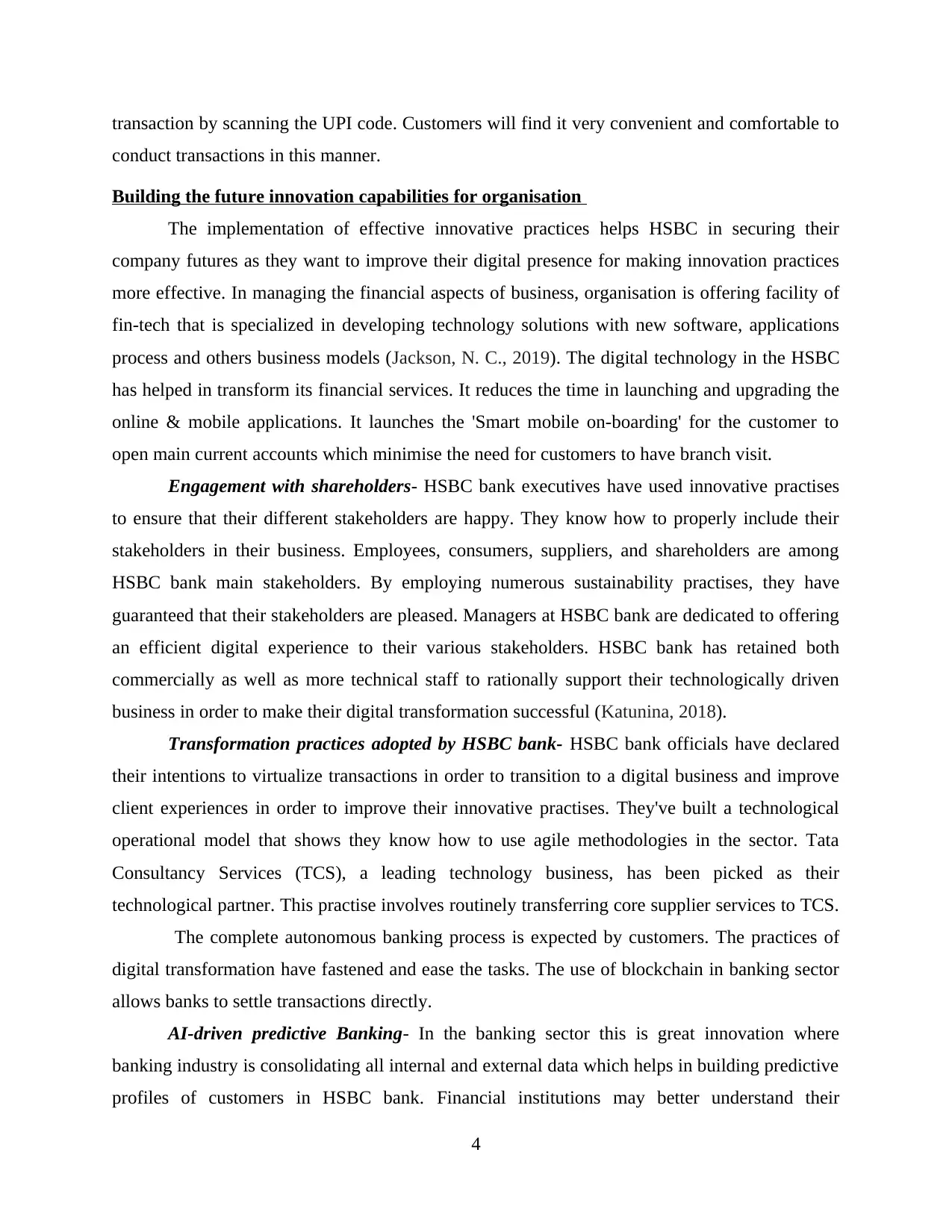
transaction by scanning the UPI code. Customers will find it very convenient and comfortable to
conduct transactions in this manner.
Building the future innovation capabilities for organisation
The implementation of effective innovative practices helps HSBC in securing their
company futures as they want to improve their digital presence for making innovation practices
more effective. In managing the financial aspects of business, organisation is offering facility of
fin-tech that is specialized in developing technology solutions with new software, applications
process and others business models (Jackson, N. C., 2019). The digital technology in the HSBC
has helped in transform its financial services. It reduces the time in launching and upgrading the
online & mobile applications. It launches the 'Smart mobile on-boarding' for the customer to
open main current accounts which minimise the need for customers to have branch visit.
Engagement with shareholders- HSBC bank executives have used innovative practises
to ensure that their different stakeholders are happy. They know how to properly include their
stakeholders in their business. Employees, consumers, suppliers, and shareholders are among
HSBC bank main stakeholders. By employing numerous sustainability practises, they have
guaranteed that their stakeholders are pleased. Managers at HSBC bank are dedicated to offering
an efficient digital experience to their various stakeholders. HSBC bank has retained both
commercially as well as more technical staff to rationally support their technologically driven
business in order to make their digital transformation successful (Katunina, 2018).
Transformation practices adopted by HSBC bank- HSBC bank officials have declared
their intentions to virtualize transactions in order to transition to a digital business and improve
client experiences in order to improve their innovative practises. They've built a technological
operational model that shows they know how to use agile methodologies in the sector. Tata
Consultancy Services (TCS), a leading technology business, has been picked as their
technological partner. This practise involves routinely transferring core supplier services to TCS.
The complete autonomous banking process is expected by customers. The practices of
digital transformation have fastened and ease the tasks. The use of blockchain in banking sector
allows banks to settle transactions directly.
AI-driven predictive Banking- In the banking sector this is great innovation where
banking industry is consolidating all internal and external data which helps in building predictive
profiles of customers in HSBC bank. Financial institutions may better understand their
4
conduct transactions in this manner.
Building the future innovation capabilities for organisation
The implementation of effective innovative practices helps HSBC in securing their
company futures as they want to improve their digital presence for making innovation practices
more effective. In managing the financial aspects of business, organisation is offering facility of
fin-tech that is specialized in developing technology solutions with new software, applications
process and others business models (Jackson, N. C., 2019). The digital technology in the HSBC
has helped in transform its financial services. It reduces the time in launching and upgrading the
online & mobile applications. It launches the 'Smart mobile on-boarding' for the customer to
open main current accounts which minimise the need for customers to have branch visit.
Engagement with shareholders- HSBC bank executives have used innovative practises
to ensure that their different stakeholders are happy. They know how to properly include their
stakeholders in their business. Employees, consumers, suppliers, and shareholders are among
HSBC bank main stakeholders. By employing numerous sustainability practises, they have
guaranteed that their stakeholders are pleased. Managers at HSBC bank are dedicated to offering
an efficient digital experience to their various stakeholders. HSBC bank has retained both
commercially as well as more technical staff to rationally support their technologically driven
business in order to make their digital transformation successful (Katunina, 2018).
Transformation practices adopted by HSBC bank- HSBC bank officials have declared
their intentions to virtualize transactions in order to transition to a digital business and improve
client experiences in order to improve their innovative practises. They've built a technological
operational model that shows they know how to use agile methodologies in the sector. Tata
Consultancy Services (TCS), a leading technology business, has been picked as their
technological partner. This practise involves routinely transferring core supplier services to TCS.
The complete autonomous banking process is expected by customers. The practices of
digital transformation have fastened and ease the tasks. The use of blockchain in banking sector
allows banks to settle transactions directly.
AI-driven predictive Banking- In the banking sector this is great innovation where
banking industry is consolidating all internal and external data which helps in building predictive
profiles of customers in HSBC bank. Financial institutions may better understand their
4
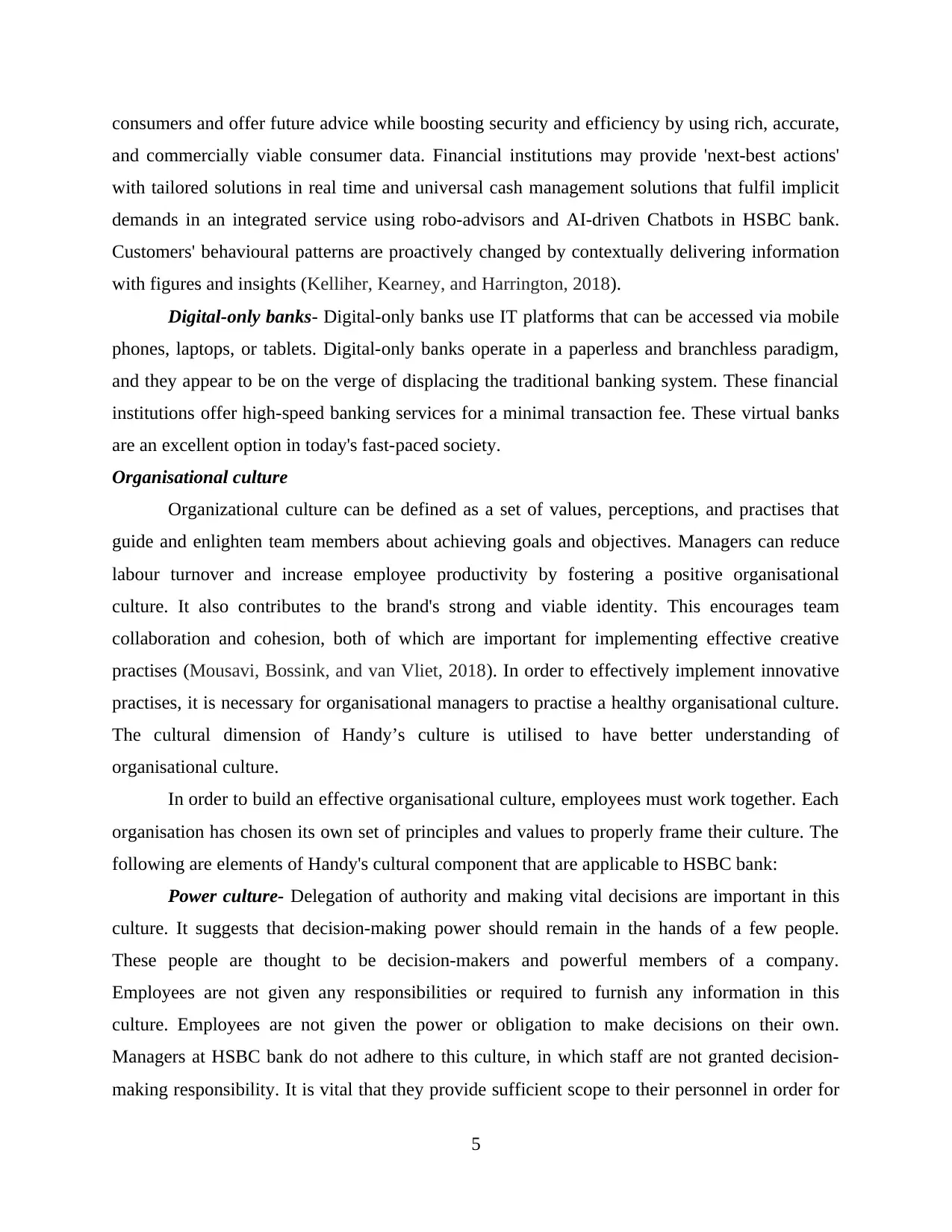
consumers and offer future advice while boosting security and efficiency by using rich, accurate,
and commercially viable consumer data. Financial institutions may provide 'next-best actions'
with tailored solutions in real time and universal cash management solutions that fulfil implicit
demands in an integrated service using robo-advisors and AI-driven Chatbots in HSBC bank.
Customers' behavioural patterns are proactively changed by contextually delivering information
with figures and insights (Kelliher, Kearney, and Harrington, 2018).
Digital-only banks- Digital-only banks use IT platforms that can be accessed via mobile
phones, laptops, or tablets. Digital-only banks operate in a paperless and branchless paradigm,
and they appear to be on the verge of displacing the traditional banking system. These financial
institutions offer high-speed banking services for a minimal transaction fee. These virtual banks
are an excellent option in today's fast-paced society.
Organisational culture
Organizational culture can be defined as a set of values, perceptions, and practises that
guide and enlighten team members about achieving goals and objectives. Managers can reduce
labour turnover and increase employee productivity by fostering a positive organisational
culture. It also contributes to the brand's strong and viable identity. This encourages team
collaboration and cohesion, both of which are important for implementing effective creative
practises (Mousavi, Bossink, and van Vliet, 2018). In order to effectively implement innovative
practises, it is necessary for organisational managers to practise a healthy organisational culture.
The cultural dimension of Handy’s culture is utilised to have better understanding of
organisational culture.
In order to build an effective organisational culture, employees must work together. Each
organisation has chosen its own set of principles and values to properly frame their culture. The
following are elements of Handy's cultural component that are applicable to HSBC bank:
Power culture- Delegation of authority and making vital decisions are important in this
culture. It suggests that decision-making power should remain in the hands of a few people.
These people are thought to be decision-makers and powerful members of a company.
Employees are not given any responsibilities or required to furnish any information in this
culture. Employees are not given the power or obligation to make decisions on their own.
Managers at HSBC bank do not adhere to this culture, in which staff are not granted decision-
making responsibility. It is vital that they provide sufficient scope to their personnel in order for
5
and commercially viable consumer data. Financial institutions may provide 'next-best actions'
with tailored solutions in real time and universal cash management solutions that fulfil implicit
demands in an integrated service using robo-advisors and AI-driven Chatbots in HSBC bank.
Customers' behavioural patterns are proactively changed by contextually delivering information
with figures and insights (Kelliher, Kearney, and Harrington, 2018).
Digital-only banks- Digital-only banks use IT platforms that can be accessed via mobile
phones, laptops, or tablets. Digital-only banks operate in a paperless and branchless paradigm,
and they appear to be on the verge of displacing the traditional banking system. These financial
institutions offer high-speed banking services for a minimal transaction fee. These virtual banks
are an excellent option in today's fast-paced society.
Organisational culture
Organizational culture can be defined as a set of values, perceptions, and practises that
guide and enlighten team members about achieving goals and objectives. Managers can reduce
labour turnover and increase employee productivity by fostering a positive organisational
culture. It also contributes to the brand's strong and viable identity. This encourages team
collaboration and cohesion, both of which are important for implementing effective creative
practises (Mousavi, Bossink, and van Vliet, 2018). In order to effectively implement innovative
practises, it is necessary for organisational managers to practise a healthy organisational culture.
The cultural dimension of Handy’s culture is utilised to have better understanding of
organisational culture.
In order to build an effective organisational culture, employees must work together. Each
organisation has chosen its own set of principles and values to properly frame their culture. The
following are elements of Handy's cultural component that are applicable to HSBC bank:
Power culture- Delegation of authority and making vital decisions are important in this
culture. It suggests that decision-making power should remain in the hands of a few people.
These people are thought to be decision-makers and powerful members of a company.
Employees are not given any responsibilities or required to furnish any information in this
culture. Employees are not given the power or obligation to make decisions on their own.
Managers at HSBC bank do not adhere to this culture, in which staff are not granted decision-
making responsibility. It is vital that they provide sufficient scope to their personnel in order for
5
Paraphrase This Document
Need a fresh take? Get an instant paraphrase of this document with our AI Paraphraser
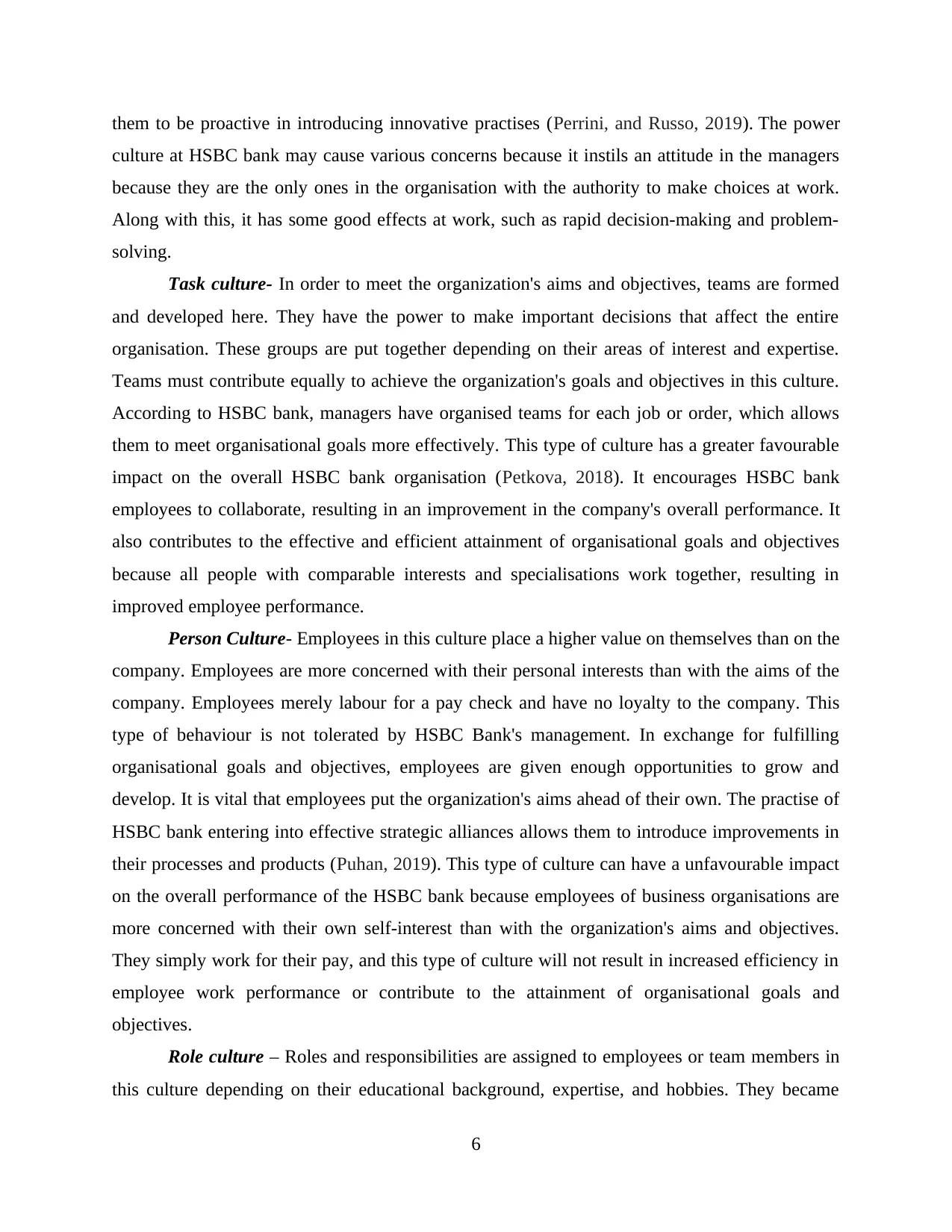
them to be proactive in introducing innovative practises (Perrini, and Russo, 2019). The power
culture at HSBC bank may cause various concerns because it instils an attitude in the managers
because they are the only ones in the organisation with the authority to make choices at work.
Along with this, it has some good effects at work, such as rapid decision-making and problem-
solving.
Task culture- In order to meet the organization's aims and objectives, teams are formed
and developed here. They have the power to make important decisions that affect the entire
organisation. These groups are put together depending on their areas of interest and expertise.
Teams must contribute equally to achieve the organization's goals and objectives in this culture.
According to HSBC bank, managers have organised teams for each job or order, which allows
them to meet organisational goals more effectively. This type of culture has a greater favourable
impact on the overall HSBC bank organisation (Petkova, 2018). It encourages HSBC bank
employees to collaborate, resulting in an improvement in the company's overall performance. It
also contributes to the effective and efficient attainment of organisational goals and objectives
because all people with comparable interests and specialisations work together, resulting in
improved employee performance.
Person Culture- Employees in this culture place a higher value on themselves than on the
company. Employees are more concerned with their personal interests than with the aims of the
company. Employees merely labour for a pay check and have no loyalty to the company. This
type of behaviour is not tolerated by HSBC Bank's management. In exchange for fulfilling
organisational goals and objectives, employees are given enough opportunities to grow and
develop. It is vital that employees put the organization's aims ahead of their own. The practise of
HSBC bank entering into effective strategic alliances allows them to introduce improvements in
their processes and products (Puhan, 2019). This type of culture can have a unfavourable impact
on the overall performance of the HSBC bank because employees of business organisations are
more concerned with their own self-interest than with the organization's aims and objectives.
They simply work for their pay, and this type of culture will not result in increased efficiency in
employee work performance or contribute to the attainment of organisational goals and
objectives.
Role culture – Roles and responsibilities are assigned to employees or team members in
this culture depending on their educational background, expertise, and hobbies. They became
6
culture at HSBC bank may cause various concerns because it instils an attitude in the managers
because they are the only ones in the organisation with the authority to make choices at work.
Along with this, it has some good effects at work, such as rapid decision-making and problem-
solving.
Task culture- In order to meet the organization's aims and objectives, teams are formed
and developed here. They have the power to make important decisions that affect the entire
organisation. These groups are put together depending on their areas of interest and expertise.
Teams must contribute equally to achieve the organization's goals and objectives in this culture.
According to HSBC bank, managers have organised teams for each job or order, which allows
them to meet organisational goals more effectively. This type of culture has a greater favourable
impact on the overall HSBC bank organisation (Petkova, 2018). It encourages HSBC bank
employees to collaborate, resulting in an improvement in the company's overall performance. It
also contributes to the effective and efficient attainment of organisational goals and objectives
because all people with comparable interests and specialisations work together, resulting in
improved employee performance.
Person Culture- Employees in this culture place a higher value on themselves than on the
company. Employees are more concerned with their personal interests than with the aims of the
company. Employees merely labour for a pay check and have no loyalty to the company. This
type of behaviour is not tolerated by HSBC Bank's management. In exchange for fulfilling
organisational goals and objectives, employees are given enough opportunities to grow and
develop. It is vital that employees put the organization's aims ahead of their own. The practise of
HSBC bank entering into effective strategic alliances allows them to introduce improvements in
their processes and products (Puhan, 2019). This type of culture can have a unfavourable impact
on the overall performance of the HSBC bank because employees of business organisations are
more concerned with their own self-interest than with the organization's aims and objectives.
They simply work for their pay, and this type of culture will not result in increased efficiency in
employee work performance or contribute to the attainment of organisational goals and
objectives.
Role culture – Roles and responsibilities are assigned to employees or team members in
this culture depending on their educational background, expertise, and hobbies. They became
6
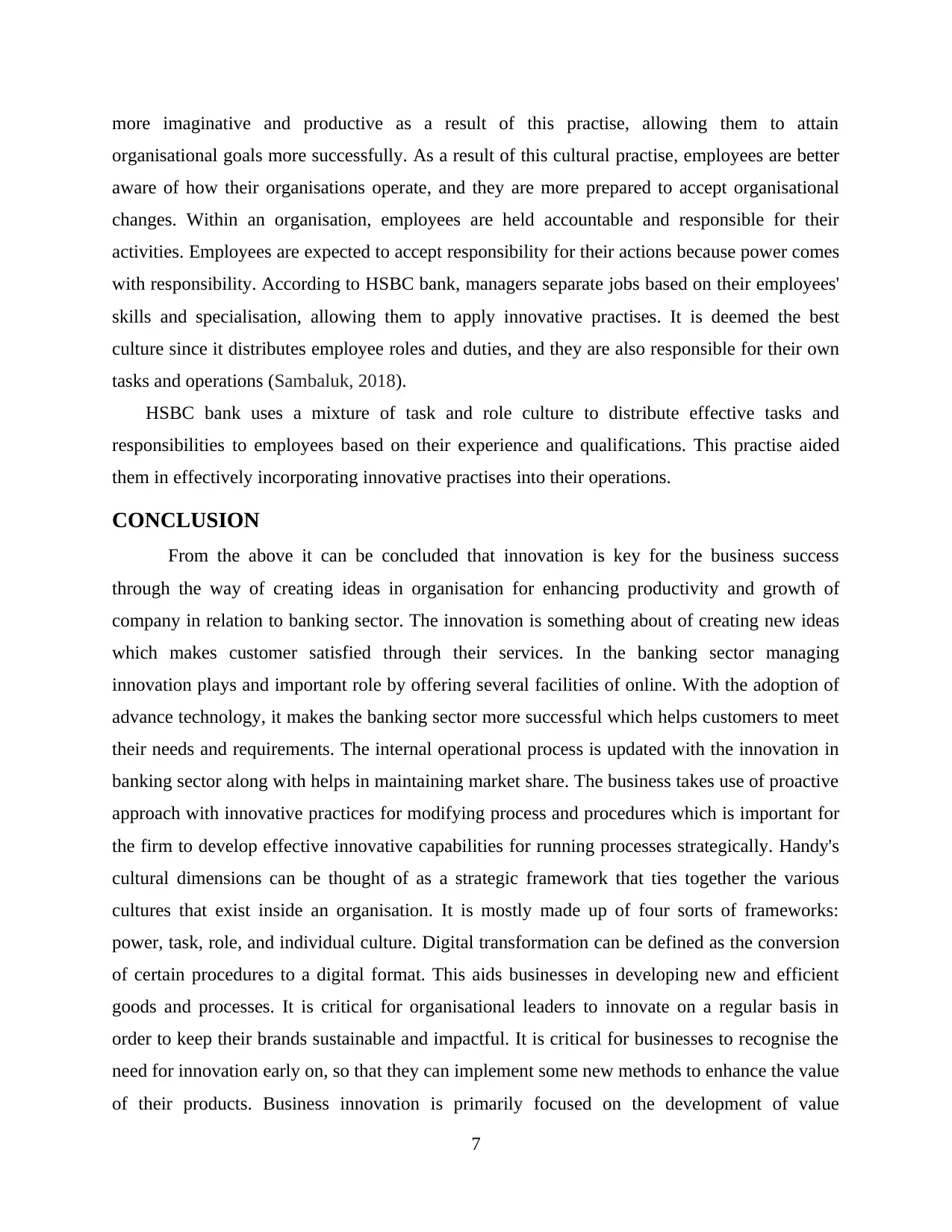
more imaginative and productive as a result of this practise, allowing them to attain
organisational goals more successfully. As a result of this cultural practise, employees are better
aware of how their organisations operate, and they are more prepared to accept organisational
changes. Within an organisation, employees are held accountable and responsible for their
activities. Employees are expected to accept responsibility for their actions because power comes
with responsibility. According to HSBC bank, managers separate jobs based on their employees'
skills and specialisation, allowing them to apply innovative practises. It is deemed the best
culture since it distributes employee roles and duties, and they are also responsible for their own
tasks and operations (Sambaluk, 2018).
HSBC bank uses a mixture of task and role culture to distribute effective tasks and
responsibilities to employees based on their experience and qualifications. This practise aided
them in effectively incorporating innovative practises into their operations.
CONCLUSION
From the above it can be concluded that innovation is key for the business success
through the way of creating ideas in organisation for enhancing productivity and growth of
company in relation to banking sector. The innovation is something about of creating new ideas
which makes customer satisfied through their services. In the banking sector managing
innovation plays and important role by offering several facilities of online. With the adoption of
advance technology, it makes the banking sector more successful which helps customers to meet
their needs and requirements. The internal operational process is updated with the innovation in
banking sector along with helps in maintaining market share. The business takes use of proactive
approach with innovative practices for modifying process and procedures which is important for
the firm to develop effective innovative capabilities for running processes strategically. Handy's
cultural dimensions can be thought of as a strategic framework that ties together the various
cultures that exist inside an organisation. It is mostly made up of four sorts of frameworks:
power, task, role, and individual culture. Digital transformation can be defined as the conversion
of certain procedures to a digital format. This aids businesses in developing new and efficient
goods and processes. It is critical for organisational leaders to innovate on a regular basis in
order to keep their brands sustainable and impactful. It is critical for businesses to recognise the
need for innovation early on, so that they can implement some new methods to enhance the value
of their products. Business innovation is primarily focused on the development of value
7
organisational goals more successfully. As a result of this cultural practise, employees are better
aware of how their organisations operate, and they are more prepared to accept organisational
changes. Within an organisation, employees are held accountable and responsible for their
activities. Employees are expected to accept responsibility for their actions because power comes
with responsibility. According to HSBC bank, managers separate jobs based on their employees'
skills and specialisation, allowing them to apply innovative practises. It is deemed the best
culture since it distributes employee roles and duties, and they are also responsible for their own
tasks and operations (Sambaluk, 2018).
HSBC bank uses a mixture of task and role culture to distribute effective tasks and
responsibilities to employees based on their experience and qualifications. This practise aided
them in effectively incorporating innovative practises into their operations.
CONCLUSION
From the above it can be concluded that innovation is key for the business success
through the way of creating ideas in organisation for enhancing productivity and growth of
company in relation to banking sector. The innovation is something about of creating new ideas
which makes customer satisfied through their services. In the banking sector managing
innovation plays and important role by offering several facilities of online. With the adoption of
advance technology, it makes the banking sector more successful which helps customers to meet
their needs and requirements. The internal operational process is updated with the innovation in
banking sector along with helps in maintaining market share. The business takes use of proactive
approach with innovative practices for modifying process and procedures which is important for
the firm to develop effective innovative capabilities for running processes strategically. Handy's
cultural dimensions can be thought of as a strategic framework that ties together the various
cultures that exist inside an organisation. It is mostly made up of four sorts of frameworks:
power, task, role, and individual culture. Digital transformation can be defined as the conversion
of certain procedures to a digital format. This aids businesses in developing new and efficient
goods and processes. It is critical for organisational leaders to innovate on a regular basis in
order to keep their brands sustainable and impactful. It is critical for businesses to recognise the
need for innovation early on, so that they can implement some new methods to enhance the value
of their products. Business innovation is primarily focused on the development of value
7
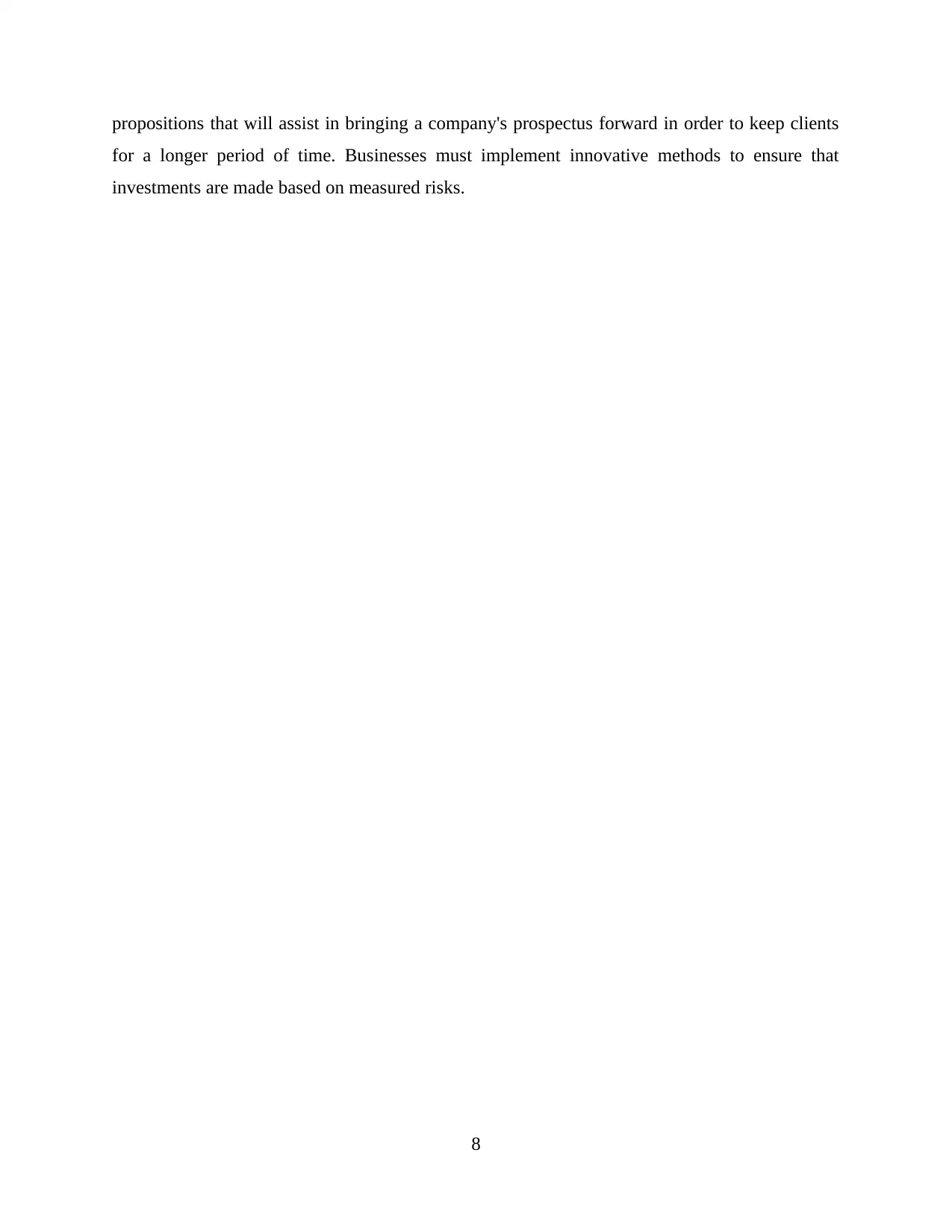
propositions that will assist in bringing a company's prospectus forward in order to keep clients
for a longer period of time. Businesses must implement innovative methods to ensure that
investments are made based on measured risks.
8
for a longer period of time. Businesses must implement innovative methods to ensure that
investments are made based on measured risks.
8
Secure Best Marks with AI Grader
Need help grading? Try our AI Grader for instant feedback on your assignments.
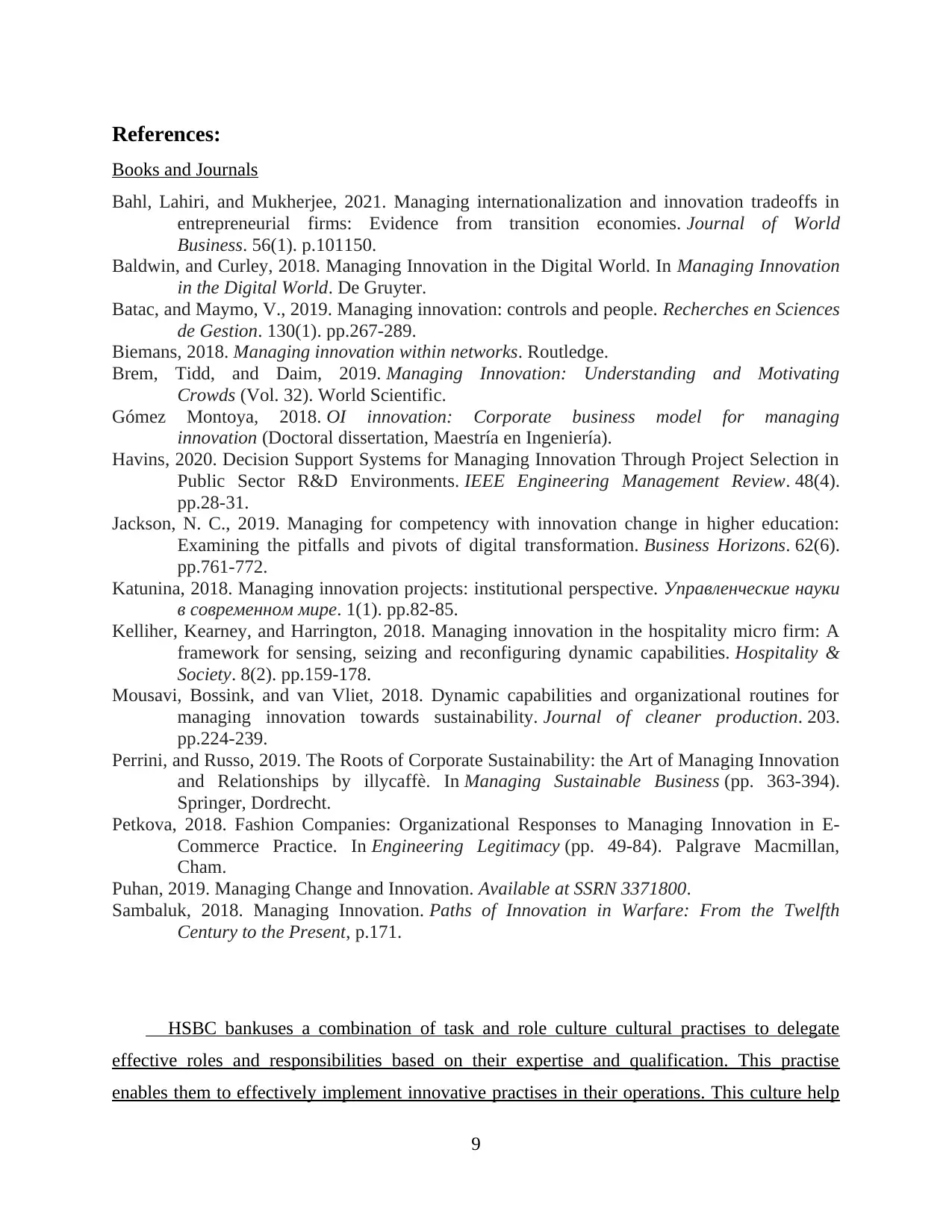
References:
Books and Journals
Bahl, Lahiri, and Mukherjee, 2021. Managing internationalization and innovation tradeoffs in
entrepreneurial firms: Evidence from transition economies. Journal of World
Business. 56(1). p.101150.
Baldwin, and Curley, 2018. Managing Innovation in the Digital World. In Managing Innovation
in the Digital World. De Gruyter.
Batac, and Maymo, V., 2019. Managing innovation: controls and people. Recherches en Sciences
de Gestion. 130(1). pp.267-289.
Biemans, 2018. Managing innovation within networks. Routledge.
Brem, Tidd, and Daim, 2019. Managing Innovation: Understanding and Motivating
Crowds (Vol. 32). World Scientific.
Gómez Montoya, 2018. OI innovation: Corporate business model for managing
innovation (Doctoral dissertation, Maestría en Ingeniería).
Havins, 2020. Decision Support Systems for Managing Innovation Through Project Selection in
Public Sector R&D Environments. IEEE Engineering Management Review. 48(4).
pp.28-31.
Jackson, N. C., 2019. Managing for competency with innovation change in higher education:
Examining the pitfalls and pivots of digital transformation. Business Horizons. 62(6).
pp.761-772.
Katunina, 2018. Managing innovation projects: institutional perspective. Управленческие науки
в современном мире. 1(1). pp.82-85.
Kelliher, Kearney, and Harrington, 2018. Managing innovation in the hospitality micro firm: A
framework for sensing, seizing and reconfiguring dynamic capabilities. Hospitality &
Society. 8(2). pp.159-178.
Mousavi, Bossink, and van Vliet, 2018. Dynamic capabilities and organizational routines for
managing innovation towards sustainability. Journal of cleaner production. 203.
pp.224-239.
Perrini, and Russo, 2019. The Roots of Corporate Sustainability: the Art of Managing Innovation
and Relationships by illycaffè. In Managing Sustainable Business (pp. 363-394).
Springer, Dordrecht.
Petkova, 2018. Fashion Companies: Organizational Responses to Managing Innovation in E-
Commerce Practice. In Engineering Legitimacy (pp. 49-84). Palgrave Macmillan,
Cham.
Puhan, 2019. Managing Change and Innovation. Available at SSRN 3371800.
Sambaluk, 2018. Managing Innovation. Paths of Innovation in Warfare: From the Twelfth
Century to the Present, p.171.
HSBC bankuses a combination of task and role culture cultural practises to delegate
effective roles and responsibilities based on their expertise and qualification. This practise
enables them to effectively implement innovative practises in their operations. This culture help
9
Books and Journals
Bahl, Lahiri, and Mukherjee, 2021. Managing internationalization and innovation tradeoffs in
entrepreneurial firms: Evidence from transition economies. Journal of World
Business. 56(1). p.101150.
Baldwin, and Curley, 2018. Managing Innovation in the Digital World. In Managing Innovation
in the Digital World. De Gruyter.
Batac, and Maymo, V., 2019. Managing innovation: controls and people. Recherches en Sciences
de Gestion. 130(1). pp.267-289.
Biemans, 2018. Managing innovation within networks. Routledge.
Brem, Tidd, and Daim, 2019. Managing Innovation: Understanding and Motivating
Crowds (Vol. 32). World Scientific.
Gómez Montoya, 2018. OI innovation: Corporate business model for managing
innovation (Doctoral dissertation, Maestría en Ingeniería).
Havins, 2020. Decision Support Systems for Managing Innovation Through Project Selection in
Public Sector R&D Environments. IEEE Engineering Management Review. 48(4).
pp.28-31.
Jackson, N. C., 2019. Managing for competency with innovation change in higher education:
Examining the pitfalls and pivots of digital transformation. Business Horizons. 62(6).
pp.761-772.
Katunina, 2018. Managing innovation projects: institutional perspective. Управленческие науки
в современном мире. 1(1). pp.82-85.
Kelliher, Kearney, and Harrington, 2018. Managing innovation in the hospitality micro firm: A
framework for sensing, seizing and reconfiguring dynamic capabilities. Hospitality &
Society. 8(2). pp.159-178.
Mousavi, Bossink, and van Vliet, 2018. Dynamic capabilities and organizational routines for
managing innovation towards sustainability. Journal of cleaner production. 203.
pp.224-239.
Perrini, and Russo, 2019. The Roots of Corporate Sustainability: the Art of Managing Innovation
and Relationships by illycaffè. In Managing Sustainable Business (pp. 363-394).
Springer, Dordrecht.
Petkova, 2018. Fashion Companies: Organizational Responses to Managing Innovation in E-
Commerce Practice. In Engineering Legitimacy (pp. 49-84). Palgrave Macmillan,
Cham.
Puhan, 2019. Managing Change and Innovation. Available at SSRN 3371800.
Sambaluk, 2018. Managing Innovation. Paths of Innovation in Warfare: From the Twelfth
Century to the Present, p.171.
HSBC bankuses a combination of task and role culture cultural practises to delegate
effective roles and responsibilities based on their expertise and qualification. This practise
enables them to effectively implement innovative practises in their operations. This culture help
9
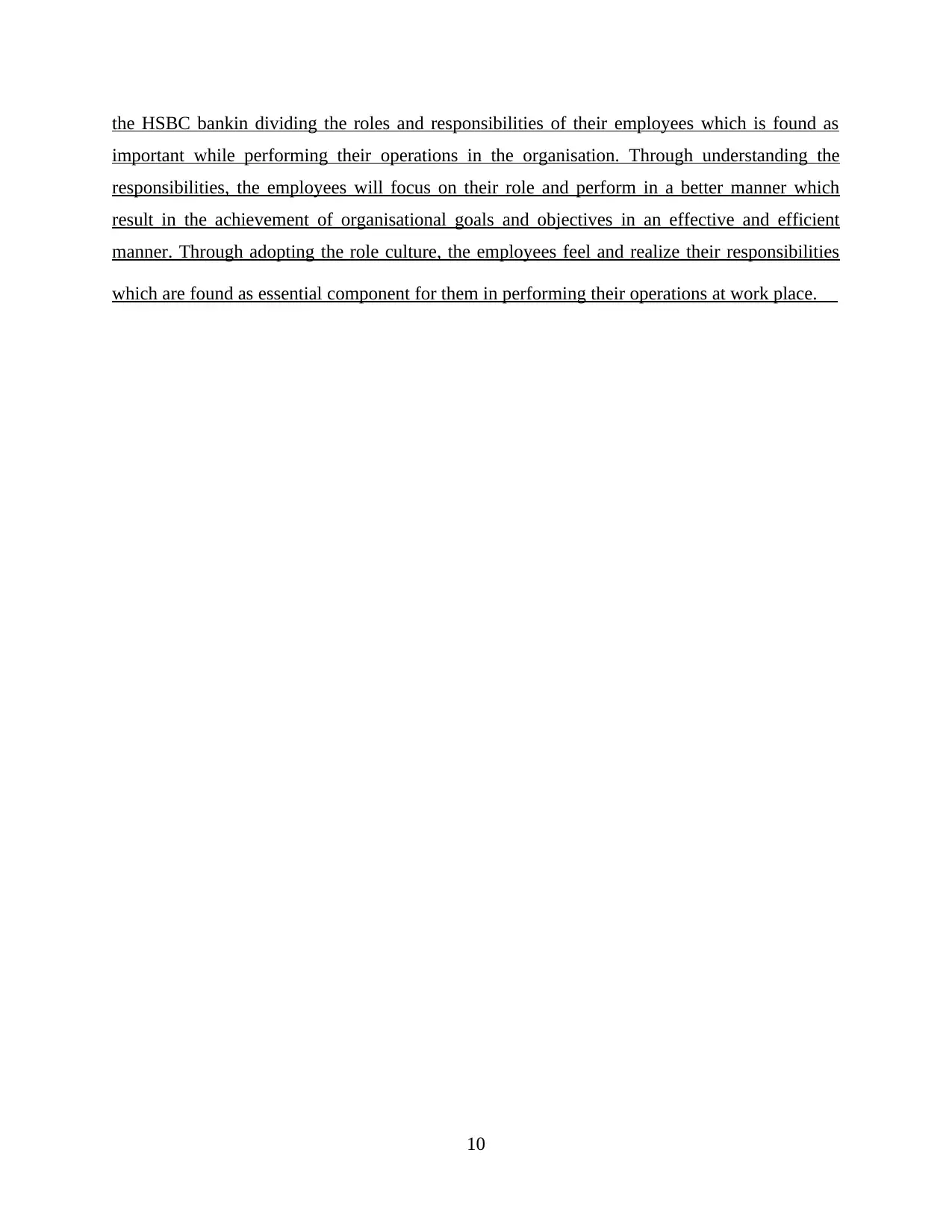
the HSBC bankin dividing the roles and responsibilities of their employees which is found as
important while performing their operations in the organisation. Through understanding the
responsibilities, the employees will focus on their role and perform in a better manner which
result in the achievement of organisational goals and objectives in an effective and efficient
manner. Through adopting the role culture, the employees feel and realize their responsibilities
which are found as essential component for them in performing their operations at work place.
10
important while performing their operations in the organisation. Through understanding the
responsibilities, the employees will focus on their role and perform in a better manner which
result in the achievement of organisational goals and objectives in an effective and efficient
manner. Through adopting the role culture, the employees feel and realize their responsibilities
which are found as essential component for them in performing their operations at work place.
10
1 out of 12
Related Documents
Your All-in-One AI-Powered Toolkit for Academic Success.
+13062052269
info@desklib.com
Available 24*7 on WhatsApp / Email
![[object Object]](/_next/static/media/star-bottom.7253800d.svg)
Unlock your academic potential
© 2024 | Zucol Services PVT LTD | All rights reserved.



